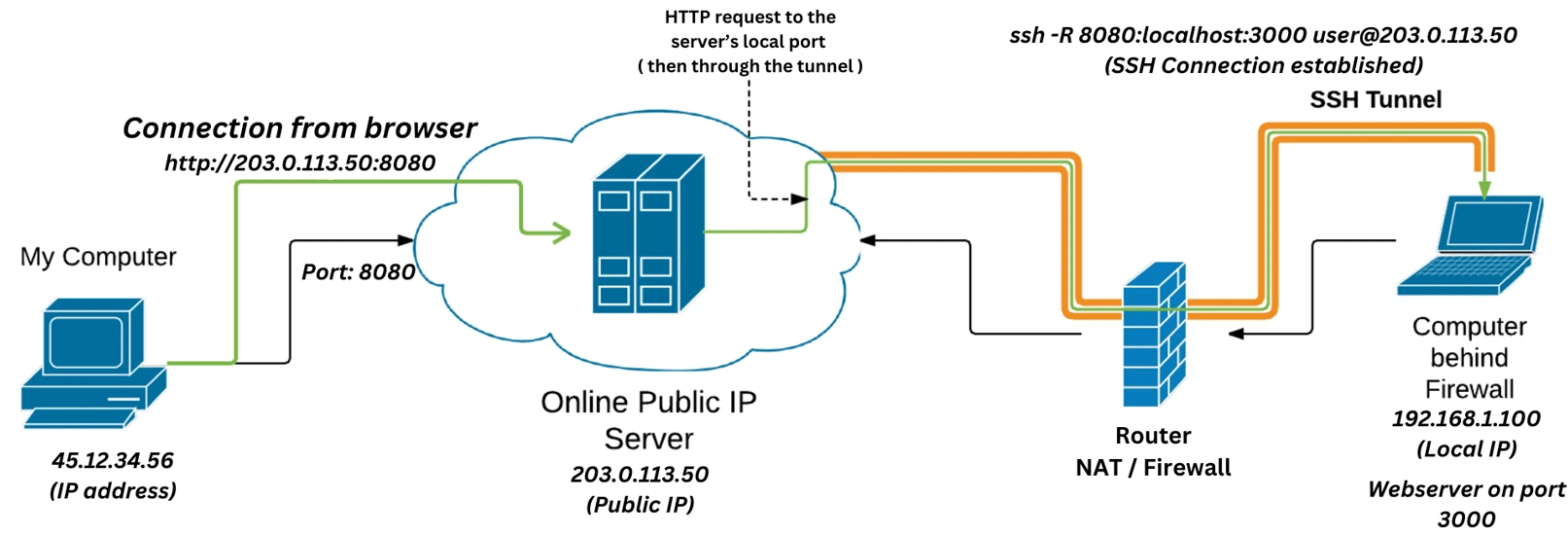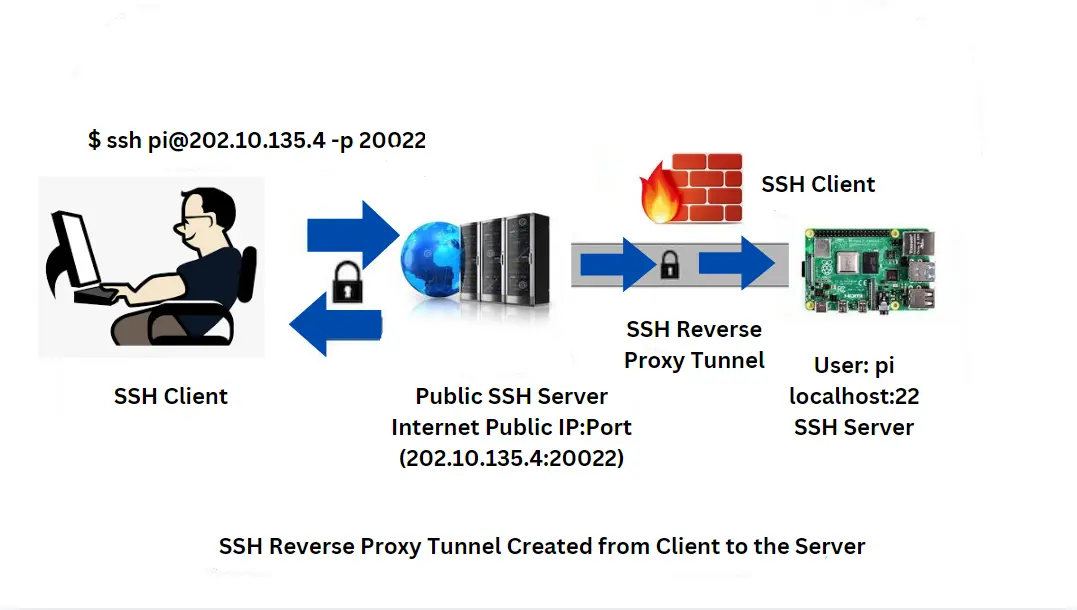SSH Reverse Tunneling
Updated on Jun 30, 2025 · 10 mins read

SSH reverse tunneling is a powerful tool that enables secure remote access to systems or services that are behind firewalls or NATs (Network Address Translation). It is often used to provide external access to local systems and services without modifying the network’s security settings. In this detailed guide, we will break down SSH reverse tunneling, explain its applications, highlight security practices, and discuss alternatives. We will then discuss how Pinggy uses SSH reverse tunneling to share applications and services from localhost.
Summary
SSH reverse tunneling allows you to expose local services to the internet, bypassing firewalls and NAT restrictions.
Basic Commands:
Create a basic reverse tunnel:
ssh -R 8080:localhost:3000 user@remote-server.comCreate a persistent tunnel with autossh:
autossh -M 0 -R 8080:localhost:3000 user@remote-server.comQuick tunneling with Pinggy:
ssh -p 443 -R0:localhost:3000 a.pinggy.io
What is SSH Reverse Tunneling?
SSH (Secure Shell) reverse tunneling allows an external machine to connect to a local machine, even if that local machine is behind a firewall or doesn’t have a public-facing IP address. Unlike typical SSH port forwarding, where traffic to a port in the local system is forwarded outward to a remote system, reverse tunneling sends traffic from the remote system back to your local machine.
This technique is especially useful for:
- Forwarding traffic from a remote system to a local system which is behind a NAT
- Bypassing firewall restrictions
- Accessing services on a local machine from a remote location
- Enabling remote debugging or testing of applications
- Managing IoT devices, servers, or databases from anywhere

How SSH Reverse Tunneling Works?
The basic principle of reverse SSH tunneling is to create a connection from a remote machine (which could be a server in the cloud) to your local machine using SSH, forwarding a port from the remote system back to a service running on your local system.
Command Syntax:
ssh -R [remote-port]:[hostname]:[port] [user]@[remote-host]-R: Defines the reverse tunnel[remote-port]: The port on the remote machine that forwards traffic[hostname]:[port]: The host and port where the local machine will forward the traffic to. Herehostnamecan simply belocalhostto forward the traffic to a service running in this local system itself.[user]@[remote-host]: Remote SSH server credentials
For example:
ssh -R 8080:localhost:3000 user@remote-server.com
In this example, any traffic to remote-server.com:8080 will be forwarded to port 3000 on your local machine, allowing a user to connect to the remote server to access your locally hosted service.
How to Set Up SSH Reverse Tunneling
Setting up SSH reverse tunneling allows you to securely forward traffic from a remote server back to your local machine. The steps may vary depending on your operating system. Here’s a guide for Linux, macOS, and Windows.
For Linux
Step 1: Ensure SSH is Installed
Most Linux distributions come with SSH pre-installed. If it’s not installed, you can add it using the following commands:
For Ubuntu/Debian:
sudo apt update
sudo apt install openssh-client
Step 2: Set Up SSH on the Remote Server
Ensure that SSH is installed and configured to allow reverse tunneling on the remote server. You’ll need to edit the SSH configuration file to allow this feature:
Open the SSH configuration file on the remote server:
sudo nano /etc/ssh/sshd_configFind the line that says
GatewayPortsand set it toyes:GatewayPorts yesRestart the SSH service to apply changes:
sudo systemctl restart sshd
Step 3: Run the SSH Reverse Tunnel Command:
To create a reverse tunnel, use the following command:
ssh -R [remote-port]:localhost:[local-port] [user]@[remote-host]
[remote-port]: The port on the remote server you want to forward.[local-port]: The port on your local machine that receives the forwarded traffic.[user]@[remote-host]: Your SSH credentials.
Example:
ssh -R 8080:localhost:3000 user@remote-server.com
This will forward traffic from 8080 on the remote server to port 3000 on your local machine.
For macOS
Step 1: Ensure SSH is Installed
macOS typically comes with SSH pre-installed. However, if it’s missing, you can install it using Homebrew:
brew install openssh
Step 2: Set Up SSH on the Remote Server
Follow the same steps as in the Linux section to configure SSH on the remote server:
- Edit
/etc/ssh/sshd_configto allow reverse tunneling:
sudo nano /etc/ssh/sshd_config
- Set
GatewayPortstoyesand restart the SSH service:
sudo systemctl restart sshd
Step 3: Run the SSH Reverse Tunnel Command
The same SSH reverse tunneling command applies to macOS:
ssh -R [remote-port]:localhost:[local-port] [user]@[remote-host]
For example, if you want to forward port 8080 on the remote server to port 3000 on your local machine:
ssh -R 8080:localhost:3000 user@remote-server.com
For Windows
You can set up SSH reverse tunneling on Windows using either OpenSSH (included in Windows 10 and later) or PuTTY.
Option 1: Using OpenSSH (Windows 10 and Later)
Step 1: Install OpenSSH (if not already installed)
To check if OpenSSH is installed, open PowerShell and run:
ssh
If OpenSSH is missing, install it from Settings > Apps > Optional Features > Add a Feature, then search for OpenSSH Client.
Step 2: Set Up SSH on the Remote Server
Configure SSH on the remote server by editing the /etc/ssh/sshd_config file as shown in the Linux section, enabling GatewayPorts.
Step 3: Run the SSH Reverse Tunnel Command
Once OpenSSH is ready, you can use the same SSH command as on Linux and macOS:
ssh -R [remote-port]:localhost:[local-port] [user]@[remote-host]
Example:
ssh -R 8080:localhost:3000 user@remote-server.com
Option 2: Using PuTTY
If you prefer a graphical interface, use PuTTY for setting up the reverse tunnel.
Step 1: Download and Install PuTTY
You can download PuTTY from the official site: PuTTY Download.
Step 2: Configure Reverse Tunneling in PuTTY
- Open PuTTY and enter the remote server’s IP in the Host Name field.
- Navigate to Connection > SSH > Tunnels.
- Under Source Port, enter the remote port you want to forward (e.g.,
8080). - Under Destination, enter
localhost:[local-port](e.g.,localhost:3000). - Select Remote.
- Click Add, then Open to establish the connection.
Step 4: Access the Tunnel (All Platforms)
Once the reverse tunnel is set up, any traffic directed to the remote server (e.g., remote-server.com:8080) will be forwarded to your local machine’s port (e.g., localhost:3000).
Optional Step: Persistent Tunnels
If you want the reverse tunnel to persist across SSH session drops or server reboots, use tools like autossh or add the reverse tunnel command to a startup script.
Common Use Cases for SSH Reverse Tunneling
1. Remote IoT Device Control
Imagine you have a Raspberry Pi running at home that controls various IoT devices (e.g., sensors, cameras).

SSH reverse tunneling enables you to control and access the Raspberry Pi securely from your office or anywhere else:
- Setup: SSH into a remote server with a reverse tunnel command:
ssh -R 9000:localhost:22 user@remote-server.com
Here, port 9000 on the remote server forwards to port 22 (SSH) on the Raspberry Pi, allowing you to SSH into your Pi through the server:
ssh -p 9000 user@remote-server.com
2. Remote Database Access
Accessing databases like MySQL that are behind a firewall can be challenging. SSH reverse tunneling allows developers to securely connect to the database from an external location without exposing the database to the public internet.
- Example: To access a MySQL database running on localhost:3306 of a local server, you could run:
ssh -R 3307:localhost:3306 user@remote-server.com
Now, the MySQL service can be accessed remotely at remote-server.com:3307 as though it were running locally.
3. Game Hosting and Network Restrictions
Some online multiplayer games may require open ports to host sessions, which can be blocked by NAT or firewall rules. SSH reverse tunneling provides an alternative by forwarding traffic from an external server to your local machine:
- Setup: If a game server runs on
localhost:25565, use reverse tunneling to allow friends to connect:
ssh -R 4000:localhost:25565 user@remote-server.com
Now others can join your game via remote-server.com:4000.
4. Troubleshooting and Common Issues
- Connection Failures: If your SSH connection fails, ensure that the remote server allows reverse tunneling (check
sshd_configfor the settingGatewayPorts). - Authentication Issues: SSH key issues are common. Ensure that your SSH key is added to the agent using
ssh-addand use the-iflag to specify the key if necessary. - Port Conflicts: If the remote server’s port is already in use, specify a different port or check which process is occupying the port using
lsof -i.
Security Best Practices for SSH Reverse Tunneling
While SSH reverse tunneling is secure, it’s important to follow best practices to prevent unauthorized access:
Use SSH keys: Disable password-based authentication on your SSH server and only allow access through public/private key pairs for better security.
PasswordAuthentication noin thesshd_configfile.Passphrase-Protected Keys: Always protect your private keys with a passphrase to avoid them being compromised in the case of theft.
Restrict Access: Limit which users and IP addresses can access the reverse tunnel by using firewall rules or specifying allowed users in
sshd_config:AllowUsers user@ip-addressMonitoring: Regularly audit SSH connections and logs to ensure that only authorized users are accessing the tunnel.
Alternatives to SSH Reverse Tunneling
While SSH reverse tunneling is a powerful tool, there are alternatives that might be more suitable in some situations:
VPN (Virtual Private Network): A VPN creates a secure tunnel for all network traffic between your machine and a remote network. This can be more scalable and easier to manage if you need access to multiple services or machines on a remote network.
Tunneling tools: Tools such Pinggy, Tailscale, etc., are specialized for sharing services such as web applications, games, etc., allowing you to expose local servers to the internet with a public URL.
Each method has its trade-offs depending on your needs, but SSH reverse tunneling excels in providing secure, flexible access to individual services.
How Pinggy Uses SSH Reverse Tunneling
Now that we’ve explored SSH reverse tunneling in detail, let’s look at Pinggy, a service that leverages reverse tunneling to make it easier for developers and users to expose their local services to the internet.
Pinggy provides a simple interface to create secure SSH reverse tunnels without the need for maintaining your own public-facing SSH server. It generates a public URL that routes traffic to your local machine, making it ideal for tasks like webhook testing, remote collaboration, and exposing IoT devices.
Here’s how you can set up an SSH reverse tunnel with Pinggy:
Basic Tunnel Setup: You can use the following command to create a reverse tunnel with Pinggy:
ssh -p 443 -R0:localhost:3000 a.pinggy.io
- This command does several parts:
- It connects to Pinggy’s public server on port
443(commonly open in firewalls). - The
-R0:localhost:3000option creates a reverse tunnel that forwards traffic from the generated public URL tolocalhost:3000on your machine, where your local service is running.
- Public URL Generation: After running the command, Pinggy provides a public URL (e.g.,
https://yourapp.a.pinggy.link). You can share this URL with others, and any requests to this URL will be forwarded to your local machine’s service.
Proxy and Firewall Compatibility: If your network blocks traditional SSH traffic, Pinggy offers an App that can create a tunnel over SSL. Additional tools like ncat and openssl to tunnel traffic through HTTPS or SSL, ensuring the tunnel remains operational even in restrictive environments. For example:
ssh -p443 -R0:localhost:4000 -o ProxyCommand="ncat --proxy-type http --proxy 192.168.2.2:3128 %h %p" a.pinggy.io
Conclusion
SSH reverse tunneling is a highly flexible and secure way to expose local services to the internet, especially in environments with restrictive firewalls or NATs. It’s an essential tool for developers, system administrators, and anyone needing remote access to local systems.
Pinggy builds on the power of SSH reverse tunneling, providing a user-friendly platform that simplifies tunnel setup and management. Whether you’re building and testing APIs, debugging mobile apps in real-time, or managing remote environments, Pinggy simplifies connectivity while prioritizing secure access.